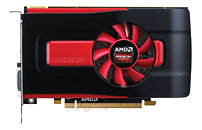- Joined
- Oct 9, 2007
- Messages
- 47,537 (7.47/day)
- Location
- Hyderabad, India
| System Name | RBMK-1000 |
|---|---|
| Processor | AMD Ryzen 7 5700G |
| Motherboard | ASUS ROG Strix B450-E Gaming |
| Cooling | DeepCool Gammax L240 V2 |
| Memory | 2x 8GB G.Skill Sniper X |
| Video Card(s) | Palit GeForce RTX 2080 SUPER GameRock |
| Storage | Western Digital Black NVMe 512GB |
| Display(s) | BenQ 1440p 60 Hz 27-inch |
| Case | Corsair Carbide 100R |
| Audio Device(s) | ASUS SupremeFX S1220A |
| Power Supply | Cooler Master MWE Gold 650W |
| Mouse | ASUS ROG Strix Impact |
| Keyboard | Gamdias Hermes E2 |
| Software | Windows 11 Pro |
AMD announced its Radeon HD 7790 mid-range graphics card, with which the company plans to fill a gap in its product-stack, between the Radeon HD 7770 GHz Edition, and the Radeon HD 7850. Based on the brand new 28 nm "Bonaire" silicon, the HD 7790 features 896 stream processors based on the Graphics CoreNext architecture, dual-independent tessellation units, 56 TMUs, 16 ROPs, and a 128-bit wide GDDR5 memory interface, holding 1 GB of memory. The core is clocked at 1.00 GHz, and memory at 6.00 GHz, churning out a memory bandwidth of 96 GB/s.
With the HD 7790, AMD is introducing an updated dynamic clock adjustment technology, which works to give games more access to the set 1.00 GHz core clock speed, which working to reduce power draw further. The technology should make the current and future AMD Radeon chips as energy-efficient as NVIDIA's. The card draws power from a single 6-pin power connector, its TDP is rated at 85W. Display outputs should typically include one or two DVI connectors, and one each of HDMI and DisplayPort. AMD is targeting a price-point of $149.99, its add-in board partners are free to launch custom-design products from day one.

View at TechPowerUp Main Site
With the HD 7790, AMD is introducing an updated dynamic clock adjustment technology, which works to give games more access to the set 1.00 GHz core clock speed, which working to reduce power draw further. The technology should make the current and future AMD Radeon chips as energy-efficient as NVIDIA's. The card draws power from a single 6-pin power connector, its TDP is rated at 85W. Display outputs should typically include one or two DVI connectors, and one each of HDMI and DisplayPort. AMD is targeting a price-point of $149.99, its add-in board partners are free to launch custom-design products from day one.

View at TechPowerUp Main Site

